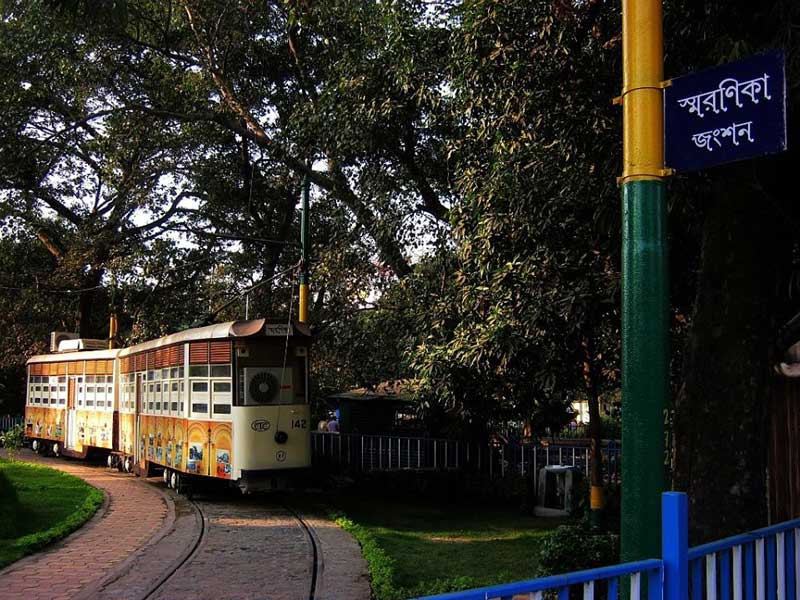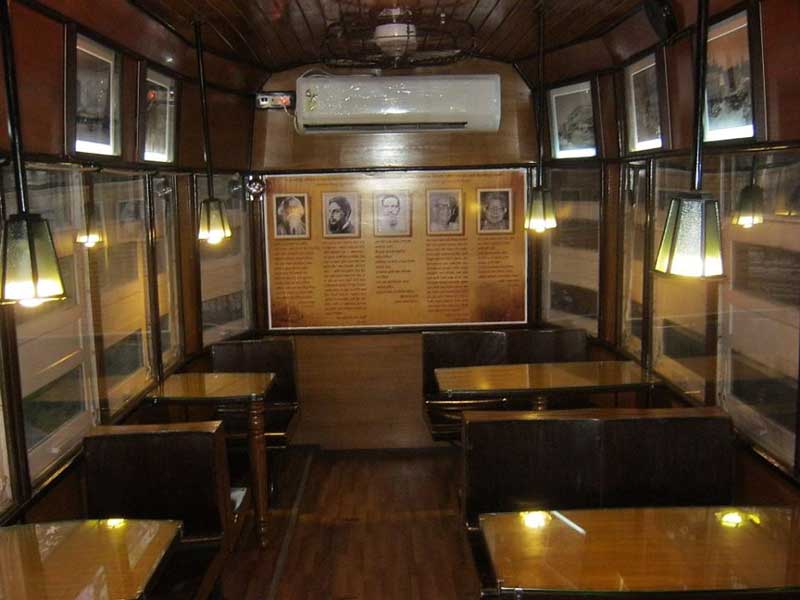
Located in the bustling Esplanade Tram Depot in the heart of the city of Calcutta and surrounded by a lush green environment, ‘Smaranika’, a gift from CTC to the tram lovers, is an Exhibition on a tram in a tram. Inaugurated in October 2014, the unique museum is housed in a vintage wooden body tram with two coaches, built-in 1938.
The tram, retired from service long back, was refurbished in CTC Nonapukur Workshop and added with a vestibule facility for enabling the visitors to move from one compartment to the other. While one compartment is converted into an air-conditioned cafeteria, the other showcases some interesting memorabilia on trams in Calcutta from the early days to the present day.

The tramways in the city of Calcutta have a history of more than a century. The horse-drawn trams were first introduced in Calcutta, the first of its kind in India, on 24 February 1873, when it covered a distance of 2.4 miles (3.9 km) from Sealdah to Armenian Ghat, for the benefit of the ferry passengers. However, this initial tramways service was discontinued on 20 November of that year, as the ferry service sponsored by the Railway Company was discontinued after the construction of the Howrah Pantoon Bridge. Later, after the formation of the Calcutta Tramway Company, registered in London on 22 December 1880, metre-gauge tram tracks were laid, following the earlier route from Sealdah to Armenian Ghat, through Bowbazar Street and after crossing Dalhousie Square, along Strand Road. However, the route was inaugurated by the Viceroy, Lord Ripon, on 1 November 1880, before the registration of the company.
It took more than two decades to modernize the new transport system, when the first electric tramcar started its journey from Esplanade to Kidderpore on 27 March 1902, followed by the service from Esplanade to Kalighat on 14 June in the same year. Gradually, the network of tramways increased and connected different parts of Calcutta and joined the city with Howrah, over the Howrah Bridge. Probably the extension of routes ended on 31 December 1986, when Behala was joined with Joka. Originally, the tram in Calcutta had two classes, the first class and second class, but since 15 Aug 2013, they have become classless.

The Calcutta Tramways was nationalized on 8 November 1976. However, though appreciated as a pollution free and eco-friendly transport system, passengers started to show aversion towards tram journey due to its comparatively slow speed. Added to it, the company had to close or discard many profitable routes for different reasons, which include the construction of the Metro Rail. To combat the changed circumstances, bus service was introduced by the Calcutta Tramways Company on 4 November 1992. But, the situation did not change, as the High Court terminus closed for the reconstruction of Strand Road in 1995, the Gariahat Depot was closed for construction of the Gariahat overpass in 2004.
To add more distress, two years later, the route from Mominpur to Behala was also closed for the construction of an overpass at Taratala. Moreover, it is considered that the trams occupy too much road space, which is impossible to provide, due to the inadequate road space and the ever increasing number of cars. The addition of the numerous flyovers and the expansion of the Calcutta Metro is also responsible to make it outdated.

Today, the CTC owns 257 trams, but only 25 runs daily. Nevertheless, efforts are on to sustain the system as an icon of the city of Calcutta, with the introduction of new types of coaches associated with front and back glass, a fibre glass ceiling, fluorescent lights, FM radio, digital display boards and angled seats To attract the people, especially the foreign tourists, a single-coach, air-conditioned banquet tram, has been introduced the attractive heritage tours of Calcutta, north in the morning and south in the evening.

Basically, the idea of a tram museum owes its origin to one Roberto D'Andrea, a tram conductor of Melbourne, who befriended fellow Calcutta conductors during his visit to the city in 1994. As he was told about a ministerial proposal of the closing the network of tramways in Calcutta, he suggested to create an art project to decorate the trams, as was done in his home city. The outcome is the Smaranika or the remembrance, an exhibition of Tram Memorabilia, located very near to the Metro Station of Calcutta Metro and consisting of two coaches of a modified tram, joined with a vestibule facility.


Before entering the unique museum, the visitor is to get a ticket from the conductor of the museum, decked in proper uniform. One part of the museum is arranged in the form of a small, but air-conditioned cafeteria, where one can relax with a cup of tea or coffee with snacks or cold beverages. The other part is the actual museum, decked with numerous items, attached to the history of the tramways in Calcutta. It houses the models of trams, used in different times for different purposes like, the earliest Horse-Drawn tram car, Flat Wagon Tram, Disinfectant Tram, Watering Tramcars, even a double bogie wooden tram car, built-in 1931, which was renovated in 2013 for the shooting of a Bengali film named Byomkesh Bakshi.

Apart from that, it showcases many interesting memorabilia, which include old tram tickets, monthly passes, uniforms, badges, armlets, caps, uniforms and pens used by tram conductors, coins, Coin Exchanger Machine and various tram parts like pull-off springs, point bar used by the pointsman to shift the tongue of a switch-point and others. However, among all the exhibits, perhaps the most important is the invaluable collection of the old photographs showing the different types of trams, which brings a nostalgic effect to the viewer.